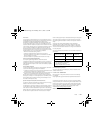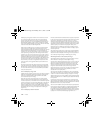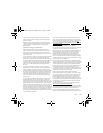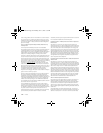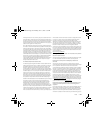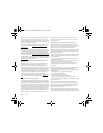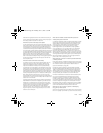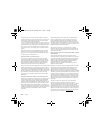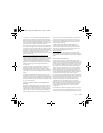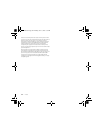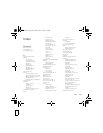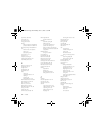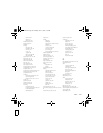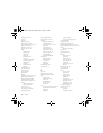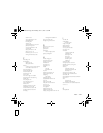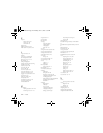
FCC :: 203
The EPA has, in the past, considered developing federal guidelines for
public exposure to RF radiation. However, EPA activities related to RF
safety and health are presently limited to advisory functions. For example,
the EPA now chairs an Inter-agency Radiofrequency Working Group,
which coordinates RF health-related activities among the various federal
agencies with health or regulatory responsibilities in this area.
OSHA is responsible for protecting workers from exposure to hazardous
chemical and physical agents. In 1971, OSHA issued a protection guide
for exposure of workers to RF radiation [29 CFR 1910.97]. However, this
guide was later ruled to be only advisory and not mandatory. Moreover, it
was based on an earlier RF exposure standard that has now been revised.
At the present time, OSHA uses the IEEE and/or FCC exposure
guidelines for enforcement purposes under OSHA's “general duty clause”
(for more information see:
http://www.osha-slc.gov/SLTC/radiofrequencyradiation/index.html
.
NIOSH is part of the U.S. Department of Health and Human Services. It
conducts research and investigations into issues related to occupational
exposure to chemical and physical agents. NIOSH has, in the past,
undertaken to develop RF exposure guidelines for workers, but final
guidelines were never adopted by the agency. NIOSH conducts safety-
related RF studies through its Physical Agents Effects Branch in
Cincinnati, Ohio.
The NTIA is an agency of the U.S. Department of Commerce and is
responsible for authorizing Federal Government use of the RF
electromagnetic spectrum. Like the FCC, the NTIA also has NEPA
responsibilities and has considered adopting guidelines for evaluating RF
exposure from U.S. Government transmitters such as radar and military
facilities.
The Department of Defense (DOD) has conducted research on the
biological effects of RF energy for a number of years. This research is now
conducted primarily at the U.S. Air Force Research Laboratory located at
Brooks Air Force Base, Texas. The DOD Web site for RF biological effects
information is listed with other sites in conjunction with a question on other
sources of information, below.
Who funds and carries out research on the biological effects of
RF energy?
Research into possible biological effects of RF energy is carried out in
laboratories in the United States and around the world. In the U.S., most
research has been funded by the Department of Defense, due to the
extensive military use of RF equipment such as radar and high-powered
radio transmitters. In addition, some federal agencies responsible for
health and safety, such as the Environmental Protection Agency (EPA)
and the U.S. Food and Drug Administration (FDA), have sponsored and
conducted research in this area. At the present time, most of the non-
military research on biological effects of RF energy in the U.S. is being
funded by industry organizations. More research is being carried out
overseas, particularly in Europe.
In 1996, the World Health Organization (WHO) established the
International EMF Project to review the scientific literature and work
towards resolution of health concerns over the use of RF technology.
WHO maintains a Web site that provides extensive information on this
project and about RF biological effects and research
(www.who.ch/peh-emf
).
FDA, EPA and other US government agencies responsible for public
health and safety have worked together and in connection with WHO to
monitor developments and identify research needs related to RF biological
effects.
How does FCC Audit Cell Phone RF?
After FCC grants permission for a particular cellular telephone to be
marketed, FCC will occasionally conduct “post-grant” testing to determine
whether production versions of the phone are being produced to conform
with FCC regulatory requirements. The manufacturer of a cell phone that
does not meet FCC's regulatory requirements may be required to remove
the cell phone from use and to refund the purchase price or provide a
replacement phone, and may be subject to civil or criminal penalties. In
addition, if the cell phone presents a risk of injury to the user, FDA may
also take regulatory action. The most important post-grant test, from a
consumer's perspective, is testing of the RF emissions of the phone. FCC
measures the Specific Absorption Rate (SAR) of the phone, following a
very rigorous testing protocol. As is true for nearly any scientific
measurement, there is a possibility that the test measurement may be less
than or greater than the actual RF emitted by the phone. This difference
between the RF test measurement and actual RF emission is because test
measurements are limited by instrument accuracy, because test
measurement and actual use environments are different, and other
variable factors. This inherent variability is known as “measurement
uncertainty.” When FCC conducts post-grant testing of a cell phone, FCC
takes into account any measurement uncertainty to when determining
whether regulatory action is appropriate. This approach ensures that
when FCC takes regulatory action, it will have a sound, defensible
scientific basis.
FDA scientific staff reviewed the methodology used by FCC to measure
cell phone RF, and agreed it is an acceptable approach, given our current
understanding of the risks presented by cellular phone RF emissions. RF
RushUG.book Page 203 Monday, June 13, 2005 1:33 PM



